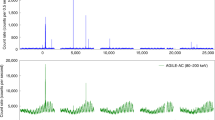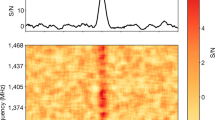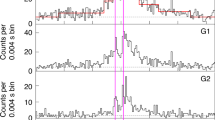Abstract
THE spatial and luminosity distribution of γ-ray bursts as observed by the BATSE instrument on the Compton Gamma Ray Observatory1,2 provides support for the revival of the idea3,4 that the burst sources are at cosmological distances5. I present here a new model for γ-ray bursts at cosmological distances, based on the formation of rapidly rotating neutron stars with surface magnetic fields of the order of 1015. Such objects could form by the gravitational collapse of accreting white dwarfs with anomalously high magnetic fields in binaries, as in magnetic cataclysmic binaries. Once formed, such rapidly rotating and strongly magnetized neutron stars would lose their rotational kinetic energy catastrophically, on a timescale of seconds or less: rotation of the magnetic field creates a strong electric field, and hence an electron–positron plasma, which I show to be optically thick and in quasi-thermodynamic equilibrium. This plasma flows away from the neutron star at relativistic speeds, and X-ray and γ-ray emission at the photosphere of this relativistic wind may then reproduce the observational characteristics of a γ-ray burst.
This is a preview of subscription content, access via your institution
Access options
Subscribe to this journal
Receive 51 print issues and online access
$199.00 per year
only $3.90 per issue
Buy this article
- Purchase on Springer Link
- Instant access to full article PDF
Prices may be subject to local taxes which are calculated during checkout
Similar content being viewed by others
References
Fishman, G. J. et al. Proc. 2nd Gamma Ray Observatory Science Workshop (in the press).
Meegan, C. A. et al. Nature 355, 143–145 (1992).
Prilutski, O. F. & Usov, V. V. Astrophys. Space Sci. 34, 395–401 (1975).
Usov, V. V. & Chibisov, G. V. Soviet Astr. 19, 115–116 (1975).
Paczynski, B. Acta astr. 41, 257–267 (1991).
Schmidt, G. D. & Liebert, J. Astrophys. Space Sci. 131, 549–557 (1987).
Latter, W. B., Schmidt, G. D. & Green, R. F. Astrophys. J. 320, 308–314 (1987).
Lightman, A. P. & Grindlay, J. E. Astrophys. J. 262, 145–152 (1982).
Manchester, R. N. & Taylor, J. H. Astr. J. 86, 1953–1973 (1981).
Lamb, F. K., Aly, J.-J., Cook, M. C. & Lamb, D. Q. Astrophys. J. 274, L71–L75 (1983).
Friedman, J. L. Phys. Rev. 51, L11–L18 (1983).
Pacini, F. Nature 219, 145–147 (1968).
Ostriker, J. P. & Gunn, J. E. Astrophys. J. 157, 1395–1417 (1969).
Arons, J. in Proc. Workshop Plasma Astrophysics, ESA SP-161, 273–286 (European Space Agency, Varenna, 1981).
Michel, F. C. Rev. mod. Phys. 54, 1–66 (1982).
Chandrasekhar, S. Astrophys. J. 161, 571–578 (1970).
Sturrock, P. A. Astrophys. J. 164, 529–556 (1971).
Ruderman, M. A. & Sutherland, P. G. Astrophys. J. 196, 51–72 (1975).
Schwinger, J. Phys. Rev. 82, 664–672 (1951).
Harding, A. K. Phys. Rep. 206, 327–391 (1991).
Machabeli, G. Z. & Usov, V. V. Soviet. Astr. Lett. 15, 393–397 (1989).
Adler, S. L. Ann. Phys. 67, 599–647 (1971).
Usov, V. V. & Shabad, A. E. Sov. Astr. Lett. 9, 212–214 (1983).
Ochelkov, Yu. P. & Usov, V. V. Astrophys. Space Sic. 96, 55–81 (1983).
Erber, T. Rev. mod. Phys. 38, 626–647 (1966).
Shabad, A. E. & Usov, V. V. Nature 295, 215–217 (1982).
Cheng, A. F. & Ruderman, M. A. Astrophys. J. 214, 598–606 (1977).
Paczynski, B. Astrophys. J. 308, L43–L46 (1986).
Goodman, J. Astrophys. J. 308, L47–L50 (1986).
Shemi, A. & Piran, T. Astrophys. J. 365, L55–L58 (1990).
Cavallo, G. & Rees, M. J. Mon. Not. R. astr. Soc. 183, 359–365 (1978).
Heuter, G. F. & Lingenfelter, R. E. in Positron–Electron Pairs in Astrophysics (eds Burns, M. L.,Harding, A. K. & Ramaty, R.) 89–93 (American Institute of Physics, New York, 1983).
Horstman, H. M. & Cavallo, G. Astr. Astrophys. 122, 119–123 (1983).
Shaham, J. J. Phys. 41, C2-9–C2-23 (1980).
Usov, V. V. Astrophys. Space Sci. 107, 191–197 (1984).
Dermer, C. D. Phys. Rev. Lett. 68, 1799–1802 (1992).
Author information
Authors and Affiliations
Rights and permissions
About this article
Cite this article
Uso, V. Millisecond pulsars with extremely strong magnetic fields as a cosmological source of γ-ray bursts. Nature 357, 472–474 (1992). https://doi.org/10.1038/357472a0
Received:
Accepted:
Issue Date:
DOI: https://doi.org/10.1038/357472a0
This article is cited by
-
Variable Chaplygin gas: constraints from supernovae, GRB and gravitational wave merger events
Astrophysics and Space Science (2023)
-
Statistical properties of the X-ray afterglow shallow decay phase and their relationships with the prompt gamma-ray emission of gamma-ray bursts
Astrophysics and Space Science (2022)
-
Recent advances in the study of the prompt emission of gamma-ray bursts
Journal of Astrophysics and Astronomy (2022)
-
Spectral index-flux relation for investigating the origins of steep decay in γ-ray bursts
Nature Communications (2021)
-
Neutron star mergers and how to study them
Living Reviews in Relativity (2020)
Comments
By submitting a comment you agree to abide by our Terms and Community Guidelines. If you find something abusive or that does not comply with our terms or guidelines please flag it as inappropriate.



